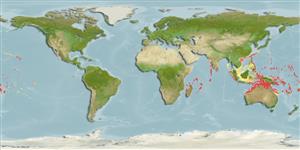>
Eupercaria/misc (Various families in series Eupercaria) >
Labridae (Wrasses)
Etymology: Labropsis: Greek, labrax, -akos = a fish, Dicentrarchus labrax + Greek,opsis = appearance (Ref. 45335).
More on author: Randall.
Environment: milieu / climate zone / depth range / distribution range
Ökologie
seewasser riff-verbunden; tiefenbereich 0 - 55 m (Ref. 2334), usually 7 - 55 m (Ref. 27115). Tropical; 24°C - 27°C (Ref. 27115); 33°N - 24°S
Indo-Pacific: East Africa to American Samoa, north to Izu Islands, south to the Great Barrier Reef.
Size / Gewicht / Alter
Maturity: Lm ? range ? - ? cm
Max length : 13.0 cm TL Männchen/unbestimmt; (Ref. 2334)
Rückenflossenstacheln (insgesamt): 9; Rückenflossenweichstrahlen (insgesamt): 11; Afterflossenstacheln 3; Afterflossenweichstrahlen: 10. Scales on lateral line: 46-49 (+2 past hypural) (Ref. 1602). Juveniles are black with several white pinstripes; females become lighter dorsally, and males develop golden centered scales, blue lines on the face, and a wedge-shaped white area in the center of the tail (Ref. 1602).
Uncommon inhabitant of coral-rich areas of clear outer lagoon and seaward reefs (Ref. 1602). May form small groups (Ref. 90102). Males generally solitary (Ref. 9710). Juveniles are cleaners while adults feed on coral polyps (Ref. 1602). Minimum depth reported taken from Ref. 128797.
Life cycle and mating behavior
Geschlechtsreife | Fortpflanzung | Ablaichen | Eier | Fecundity | Larven
Oviparous, distinct pairing during breeding (Ref. 205).
Randall, J.E., G.R. Allen and R.C. Steene, 1990. Fishes of the Great Barrier Reef and Coral Sea. University of Hawaii Press, Honolulu, Hawaii. 506 p. (Ref. 2334)
IUCN Rote Liste Status (Ref. 130435)
Bedrohung für Menschen
Harmless
Nutzung durch Menschen
Aquarium: Kommerziell
Mehr Information
ReferenzenAquakulturAquakultur ProfilZuchtlinienGenetikElectrophoresesVererbbarkeitKrankheitenVerarbeitungNutrientsMass conversion
PartnerBilderStamps, Coins Misc.LauteCiguateraGeschwindigkeitSchwimmstilKiemenoberflächeOtolithsGehirngrößeSehfähigkeit
Tools
Zusatzinformationen
Download XML
Internet Quellen
Estimates based on models
Preferred temperature (Ref.
123201): 25.9 - 28.8, mean 27.6 °C (based on 554 cells).
Phylogenetic diversity index (Ref.
82804): PD
50 = 0.5156 [Uniqueness, from 0.5 = low to 2.0 = high].
Bayesian length-weight: a=0.00912 (0.00472 - 0.01763), b=3.06 (2.90 - 3.22), in cm total length, based on LWR estimates for this species & (Sub)family-body (Ref.
93245).
Trophic level (Ref.
69278): 2.9 ±0.55 se; based on food items.
Widerstandsfähigkeit (Ref.
120179): hoch, Verdopplung der Population dauert weniger als 15 Monate. (Preliminary K or Fecundity.).
Fishing Vulnerability (Ref.
59153): Low vulnerability (10 of 100).
Nutrients (Ref.
124155): Calcium = 99.3 [57.5, 169.4] mg/100g; Iron = 0.799 [0.464, 1.460] mg/100g; Protein = 18.2 [15.3, 20.4] %; Omega3 = 0.16 [0.10, 0.25] g/100g; Selenium = 27.2 [16.7, 48.3] μg/100g; VitaminA = 132 [40, 502] μg/100g; Zinc = 1.98 [1.36, 3.23] mg/100g (wet weight);
